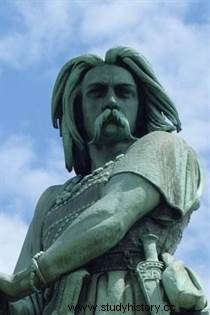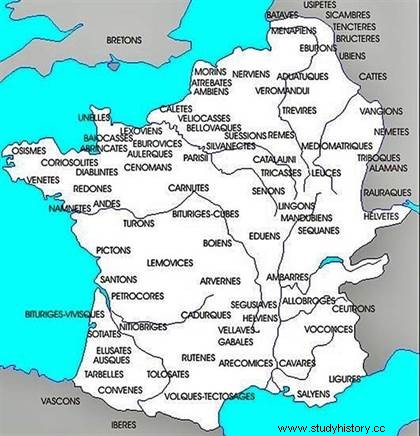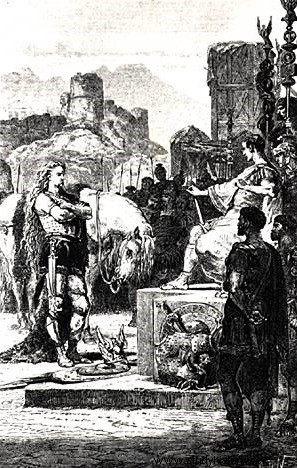 Vercingetorix (72-46 BCE) was a Gallic aristocrat and chief of the Arverni tribe. At the head of a coalition of Gallic peoples, he stood up to the Roman armies before having to capitulate during the siege of Alesia. Vercingetorix, defeated by Caesar, almost single-handedly embodies a national myth dating back to the “Gauls”, a symbol of resistance and character against the occupier. But myth is the right word, since Vercingetorix has been partly "constructed" for two centuries by politicians and certain historians to serve as the basis for a national novel. Indeed, we ultimately know very little about him, and writing his biography has long been a challenge for specialists.
Vercingetorix (72-46 BCE) was a Gallic aristocrat and chief of the Arverni tribe. At the head of a coalition of Gallic peoples, he stood up to the Roman armies before having to capitulate during the siege of Alesia. Vercingetorix, defeated by Caesar, almost single-handedly embodies a national myth dating back to the “Gauls”, a symbol of resistance and character against the occupier. But myth is the right word, since Vercingetorix has been partly "constructed" for two centuries by politicians and certain historians to serve as the basis for a national novel. Indeed, we ultimately know very little about him, and writing his biography has long been a challenge for specialists.
The source problem
The first problem for any historian concerns the sources available to talk about his subject. As far as Vercingetorix is concerned, this is a major problem. Indeed, a large part of these sources are of Latin origin (some would say "enemy"), and the large part is represented by "The Gallic Wars".
This work is written by Julius Caesar, the main opponent of the Gallic leader. But fortunately, historians have other materials at their disposal:archeology and coins, which shed new light on certain aspects of the character and especially of his time, essential to understanding his role and his actions.
The Vercingetorix man
The essential image of Vercingetorix is the famous statue of Alise Sainte-Reine, which is in fact inspired by the person who commissioned it, Napoleon III, one of great artisans of the mythification of the Gallic leader. Sources, like coins, don't help much to know what he looked like; we can finally say that he was certainly hairless, which contrasts with the legend of the Gauls bearded and hairy, a little shaggy...
 The name is more important; there have been many debates, but it emerges that the surname can be divided into several parts:“ouer”, which would mean “super”; “kinguès”, for “hero” or “warrior”; and especially “riks”, for “king”. Which would give more or less "supreme king of warriors", more a title than a name after all.
The name is more important; there have been many debates, but it emerges that the surname can be divided into several parts:“ouer”, which would mean “super”; “kinguès”, for “hero” or “warrior”; and especially “riks”, for “king”. Which would give more or less "supreme king of warriors", more a title than a name after all.
Vercingetorix's family origins are more interesting:he would be the son of Celtill, a great Arvernian chief who had royal inclinations that would have led him to be assassinated by his entourage. It is more difficult to know his place of birth and especially his date. He indeed seems, according to the sources, to have been quite young during the events that made him famous. Caesar himself uses the vague term adulescens , which may suggest that Vercingetorix was probably under thirty years old and that he had not held political office, at least in the sense understood by the Romans.
As for the rest, it is quite impossible to know what Vercingetorix's life was like before his encounter with Rome, and especially with Julius Caesar.
The Gallic Wars
One of the great debates that has rocked the historiography of Gaul is the relationship between Caesar and Vercingetorix. Did the latter know the Roman proconsul before fighting him; indeed, had he fought under his orders? Some Latin sources consider Vercingetorix to be a traitor and his actions (military and political) suggest that he was inspired by the Roman by being in contact with him. We can therefore advance the fact that Vercingetorix probably served Caesar's legions at the beginning of the Gallic Wars, in the Arvernian contingent, as did other Gallic leaders who later revolted (among the Aedui for example).
We are not going to go back here to the course of the Gallic Wars until the year 53, but to focus on the entry into the running of Vercingétorix during the decisive year 52. Julius Caesar did not see coming, it seems, the general uprising which threatens from the end of the year 53, an uprising organized by several heads of Gallic tribes, including Vercingetorix l'Arverne. This one organizes a coup against his uncle, according to Caesar, and is elected king by his supporters in the Arverne country, before being joined by other peoples such as the Senones, the Parisii and the peoples of the West. , who soon entrust him with the supreme command. In the end, we don't know much, if anything, about the circumstances of this coming to power of Vercingetorix, and especially about what happened between his service as an ally of the legions and the uprising of 53-52.
 For the rest of the Gallic Wars, the main source still being Caesar, it must obviously be taken with a grain of salt . One can notice the opposition of two very different armies, the very organized legions on one side and the scattered contingents on the other, whose elite would be the cavalry of the noble Gauls. But we must also note the skill of Vercingetorix, who continues diplomacy while recruiting new troops, and his ability to surprise his opponent. The latter launched a counter-offensive which led to very tough sieges, such as that of Avaricum (Bourges). Despite the loss of this city, Vercingetorix can still hope thanks to the rallying of new peoples, including the most faithful allies of Rome until then, the Aedui. Above all, he managed to push back Caesar's legions in -52 in Gergovia...
For the rest of the Gallic Wars, the main source still being Caesar, it must obviously be taken with a grain of salt . One can notice the opposition of two very different armies, the very organized legions on one side and the scattered contingents on the other, whose elite would be the cavalry of the noble Gauls. But we must also note the skill of Vercingetorix, who continues diplomacy while recruiting new troops, and his ability to surprise his opponent. The latter launched a counter-offensive which led to very tough sieges, such as that of Avaricum (Bourges). Despite the loss of this city, Vercingetorix can still hope thanks to the rallying of new peoples, including the most faithful allies of Rome until then, the Aedui. Above all, he managed to push back Caesar's legions in -52 in Gergovia...
It is in the capital of the Aedui, Bibracte, that Vercingetorix is confirmed as supreme leader of the insurrection. The Arverni warchief then continues his war of harassment and his scorched earth policy, while still avoiding pitched battles against legions much better trained in this terrain. Meanwhile, Caesar does not hesitate to appeal to the Germans, while one of the reasons given for his intervention in Gaul was to defend it against them. It is apparently partly thanks to the German horsemen that Caesar won a cavalry battle against the Gauls during August 52 BC. Vercingetorix was led to settle in the oppidum of Alesia...
The surrender of Vercingetorix and his death
 The siege of Alesia by the Roman army is well known, by sources, as "The Gallic Wars by Caesar, but also by archaeology. It would indeed seem that the debate is closed, and that the site of the battle is indeed that of Alise Sainte-Reine.
The siege of Alesia by the Roman army is well known, by sources, as "The Gallic Wars by Caesar, but also by archaeology. It would indeed seem that the debate is closed, and that the site of the battle is indeed that of Alise Sainte-Reine.
Vercingetorix is often criticized for allowing himself to be locked up in this oppidum, but one cannot however question his qualities as a general and explain his defeat by strategic errors major events, including this withdrawal to Alésia. It is likely that the Gallic leader tried to renew the tactics successfully applied a few months earlier during the siege of Gergovie (Clermont Ferrand region). But this time, Caesar learned the lesson and his Roman legions surrounded Alesia with a double system of fortifications. The relief army made up of many Gallic peoples who arrived at the end of September 52 broke their teeth there. Not having the means to sustain the siege any longer, Vercingetorix has no choice but to surrender.
The surrender is related by three ancient authors, Plutarch, Florus and Dio Cassius, but they cannot be considered faithful to what really happened, and not only because of the origin of the authors. The scene, repeated many times later, is obviously idealized. The reality is probably much more "mundane", even if the details escape us...
The same goes for the sequel, which further demythologizes the character of Vercingetorix. We hardly know how he was treated by Caesar once taken prisoner. We only know that he was taken to Rome with other captives, presented much later, in 46, during Caesar's triumph, then executed shortly afterwards. It is probably these mysteries and these gray areas that subsequently made it possible to build the Vercingetorix myth, still alive today despite the work of historians. After this ultimate resistance, Gaul will become a very prosperous Roman province, the centerpiece of the future Roman Empire.
Bibliography
- Vercingetorix, by Jean-Louis Brunaux. Gallimard, 2018.
- Vercingetorix by Georges Bordonove. Pocket, 2009.
- J. CESAR, The Gallic War. Classic folio, 1981.
